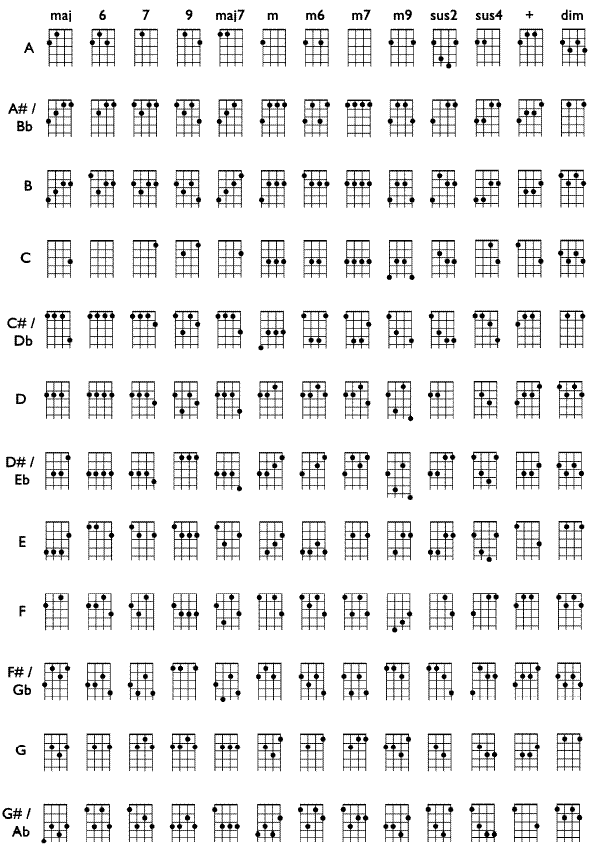

A few of our latest lessons include common blues chord progressions, pompeii guitar chords, and a discussion of guitar rig vs amplitube.Ĭosmic Music: Musical Keys to the Interpretation of Reality, essays by Marius Schneider, Rudolf Haase, and Hans Erhard Lauer

ALL CHORDS LIST FREE
Make it your friend-you won’t be sorry.Īnd if you haven’t downloaded the Uberchord app yet, here are five great reasons why you should! Not only will you get instant feedback on your fingerings and chord changes, but here on our blog there are loads of free lessons to enjoy. The key of A, for example, is so resiliently joyful it can handle life lessons like Pearl Jam’s “Alive.”įor a sense of transcendent, in-spite-of-it-all joy, you just can’t beat A major. Have you noticed yet that each key- and even each chord- that you play has its own particular emotional character? Not everyone is capable of picking up on this, but if you do notice it, consider yourself one of the lucky ones who can respond to music’s more subtle nuances! As you play them and get used to their sound, you’ll hopefully realise that you’ve heard these progressions before in many different songs. Most of the songs you hear are made up of combinations of these and other chord progressions. The following are a few common chord progressions in this key. Obviously you can’t just start playing all these chords and expect to make celestial-sounding music. So let’s have another look at the chords in the key of A: A major, B minor, C# minor, D Major, E Major, F# Minor, and G# Diminished. Here is out previous post on understanding and playing 7th chords and if you want to go more deeply into chord progressions, don’t miss series on learning and understanding music theory.Īfter your Uberchordlessons you can take a little time to experiment with the following progressions to get a feel for how the chords create a sense of beginning, rising, falling, and ending, depending on their context. “Hello Mary Lou,” as sung by Creedence Clearwater Revival !function(e,r,d)(document,”script”,”uberchord-jssdk”)
ALL CHORDS LIST FOR FREE
It looks simple enough, but playing the basic A Major chord can be a little tough if you’ve got large fingers, as your second, third, and fourth fingers have to crowd close together without touching the other strings.īut if you’re finding that the A chord is tough to play, don’t worry- any chord is playable with practice! Even better, the Uberchord app ( click for free download) can reduce the amount of practice needed by listening and providing you real time feedback. The A Chord Positions on the Guitar: Three Little Soldiers Common Chord Progressions in the Key of A Major.Theory and Practise: The Pattern of the A Major Scale Explained.The A Chord Positions on the Guitar: Three Little Soldiers.emotional connections. Learn everything you need to know about about major scales and how they work. The key of A, with only three accidentals- sharps- is fairly easy to play on the guitar, and it’s an easy key to sing in. In popular music you naturally find it among bands with an optimist twist but also, ironically, with bluesier performers like Eric Clapton and Adele (its slightly earthy character almost rivals the key of E). It’s often found in chamber music (notably for composers Schubert, Dvo ř ák, Brahms, Franck, Fauré) perhaps because it’s considered the simplest key for violins and is reputed to have the fullest sound. A Major wasn’t so often used in the Romantic Era (it’s the key of Beethoven’s famous 7th Symphony and Mendelssohn’s 4th, but little else), but it was Mozart’s favourite key for clarinets and he stuck to it when wriitng music specifically for this instrument. Not quite as popular in classical music history as keys with fewer sharps (like D and G), A Major does have its place. That’s the emotional quality of much of the music written in the key of A. Why? Because life is good and somebody up there cares. Sure, you miss your earth angel already, but you know he or she will be back in your world before you know it. Think of this key as the feeling you get when your darlin’ has to get back on the bus. Presenting you another article in our “Chord of the Week” series, where we share a new guitar chord every week, exploring its history, its relevance, how it’s played on the guitar, its major scale, some common chord progressions, and a few popular songs in its key.


 0 kommentar(er)
0 kommentar(er)
